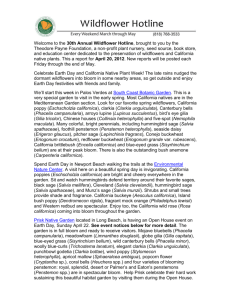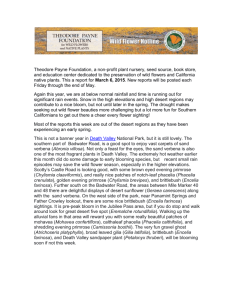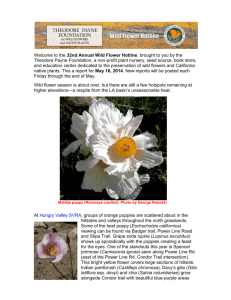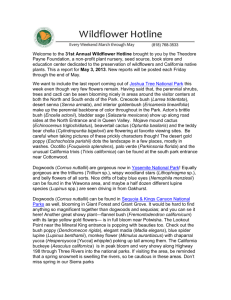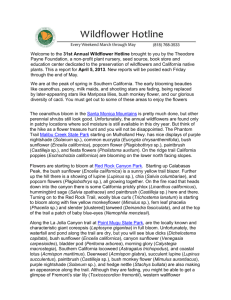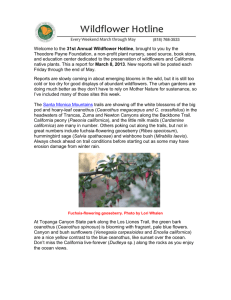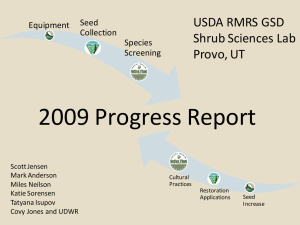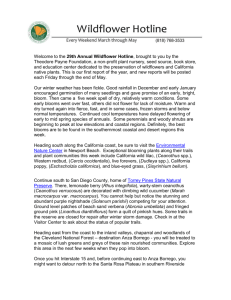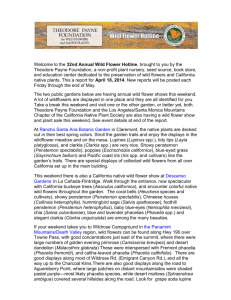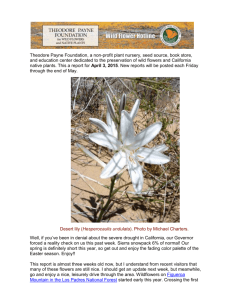April 25, 2014 – Word Doc - Theodore Payne Foundation
advertisement
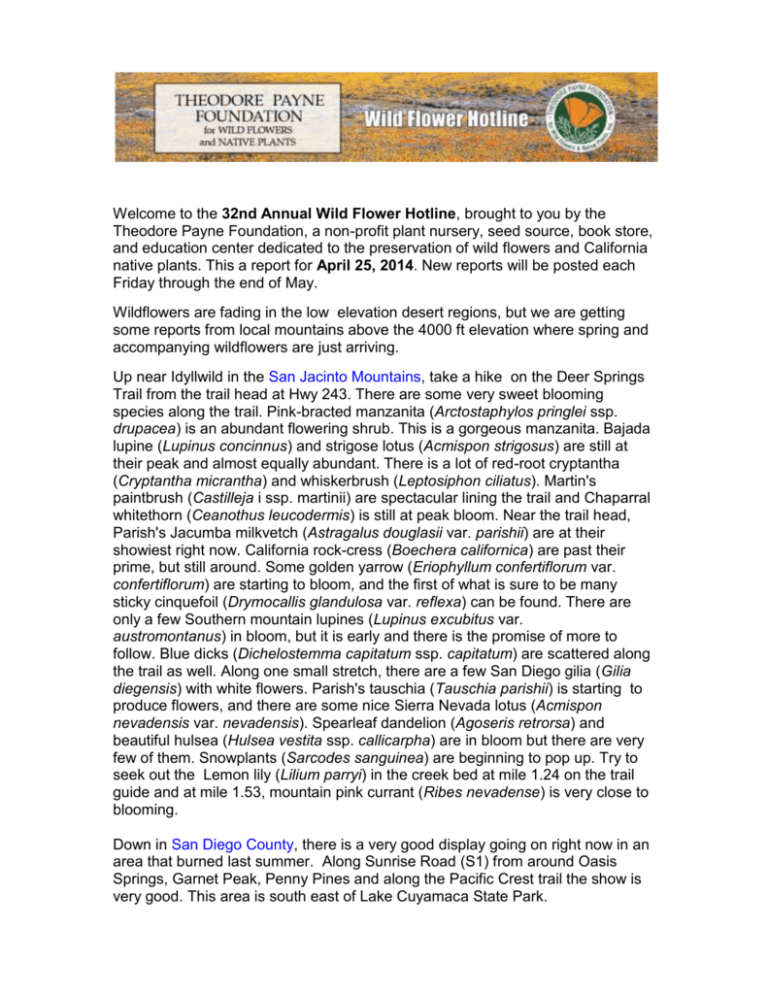
Welcome to the 32nd Annual Wild Flower Hotline, brought to you by the Theodore Payne Foundation, a non-profit plant nursery, seed source, book store, and education center dedicated to the preservation of wild flowers and California native plants. This a report for April 25, 2014. New reports will be posted each Friday through the end of May. Wildflowers are fading in the low elevation desert regions, but we are getting some reports from local mountains above the 4000 ft elevation where spring and accompanying wildflowers are just arriving. Up near Idyllwild in the San Jacinto Mountains, take a hike on the Deer Springs Trail from the trail head at Hwy 243. There are some very sweet blooming species along the trail. Pink-bracted manzanita (Arctostaphylos pringlei ssp. drupacea) is an abundant flowering shrub. This is a gorgeous manzanita. Bajada lupine (Lupinus concinnus) and strigose lotus (Acmispon strigosus) are still at their peak and almost equally abundant. There is a lot of red-root cryptantha (Cryptantha micrantha) and whiskerbrush (Leptosiphon ciliatus). Martin's paintbrush (Castilleja i ssp. martinii) are spectacular lining the trail and Chaparral whitethorn (Ceanothus leucodermis) is still at peak bloom. Near the trail head, Parish's Jacumba milkvetch (Astragalus douglasii var. parishii) are at their showiest right now. California rock-cress (Boechera californica) are past their prime, but still around. Some golden yarrow (Eriophyllum confertiflorum var. confertiflorum) are starting to bloom, and the first of what is sure to be many sticky cinquefoil (Drymocallis glandulosa var. reflexa) can be found. There are only a few Southern mountain lupines (Lupinus excubitus var. austromontanus) in bloom, but it is early and there is the promise of more to follow. Blue dicks (Dichelostemma capitatum ssp. capitatum) are scattered along the trail as well. Along one small stretch, there are a few San Diego gilia (Gilia diegensis) with white flowers. Parish's tauschia (Tauschia parishii) is starting to produce flowers, and there are some nice Sierra Nevada lotus (Acmispon nevadensis var. nevadensis). Spearleaf dandelion (Agoseris retrorsa) and beautiful hulsea (Hulsea vestita ssp. callicarpha) are in bloom but there are very few of them. Snowplants (Sarcodes sanguinea) are beginning to pop up. Try to seek out the Lemon lily (Lilium parryi) in the creek bed at mile 1.24 on the trail guide and at mile 1.53, mountain pink currant (Ribes nevadense) is very close to blooming. Down in San Diego County, there is a very good display going on right now in an area that burned last summer. Along Sunrise Road (S1) from around Oasis Springs, Garnet Peak, Penny Pines and along the Pacific Crest trail the show is very good. This area is south east of Lake Cuyamaca State Park. Short- lobed phacelia (Phacelia brachyloba) on burn site in San Diego County. Photo by Jim Duggan Figueroa Mountain in the Los Padres National Forest is not as spectacular as in years past, but makes for a nice drive to play hide and seek with wild flowers. Ranger Peak to Cachuma Saddle is where one will find the most colorful area. There are quite a few bush poppies (Dendromecon rigida) blooming along this south facing slope along with some monkey flowers (Mimulus spp.). Along the midway portion of this road, the bush lupines (Lupinus sp.) are also in bloom on both sides of the road, creating a lovely stretch. However, unlike years with more rain, the bush lupines are only about 2 feet tall, when normally they are about 4 feet. The one thing that the lack of rain did not affect is their glorious aroma. Another lovely location is the area where the old Cachuma Campground used to be. Since this area is nestled next to a year round running creek, one will find a generous amount of fiesta flowers (Pholistoma auritum) blooming in the shaded areas beneath the oaks. In the sunny field, parallel to the creek, fiesta flowers and poppies can be found. As you head out of this area, Indian paintbrush (Castilleja sp.) is also in bloom. In the Panamint Mountains/Death Valley region, wild flowers can be found along Hwy 190 over Towne Pass, with good concentrations just east of the summit, where there are large numbers of golden evening primrose (Camissonia brevipes) and desert dandelion (Malacothrix glabrata) interspersed with Fremont phacelia (Phacelia fremontii), and caltha-leaved phacelia (Phacelia calthifolia). There are good displays along most of Wildrose Rd. (Emigrant Canyon Rd.), and all the way up to the Charcoal Kilns. There are also good displays along the road to Aguereberry Point, where large patches on distant mountainsides were shaded pastel purple—most likely phacelia species, while desert mallows (Sphaeralcea ambigua) covered several hillsides along the road. Look for grape soda lupine (Lupinus excubitus), Booth’s primrose (Camissonia boothii), rock nettle (Eucnide urens), the very cute spiny-herb (Chorizanthe rigida), desert larkspur (Delphinium parishii), Fremont’s dapplepod (Astragalus lentiginosus var. fremontii), Panamint plume (Stanleya elata) and royal Mojave lupine (Lupinus odoratus). Lupine in the Panamint Mountains. Photo by Don Vogt. If you want to take a pleasant hike at Stough Canyon Nature Center this weekend, look for the cheery yellow bush sunflower (Encelia californica), monkey flower (Mimulus aurantiacus), arroyo lupine (Lupinus succulentus), and pretty pink prickly phlox (Leptodactylon californicum). The hills around the LA Zoo, Gene Autry Museum Griffith Park area are spotted with color here and there. Enjoy the California poppies (Eschscholzia californica), Matilija poppies (Romenya coulteri), California buckeye (Aesculus californica), Chinese houses (Collinsia heterophylla), and in the swale on the Zoo side of the cross walk to the Autry, is the amazing toyon (Heteromeles arbutifolia) blooming early. Also find lupines (Lupinus sp.) bush sunflower (Encelia californica), Cleveland sage (Salvia clevelandii), and white sage (Salvia apiana), The best bloom along the Angeles Crest Hwy, Big and Little Tujunga Canyon Roads in the Angeles National Forest, is happening between 2,000 and 4,500 ft. Look for patches of lupine (Lupinus spp.) and Indian paintbrush (Castilleja sp.), bush poppy (Dendromecon rigida), and scarlet bugler (Penstemon centranthifolius) and sticky monkeyflower (Mimulus aurantiacus) along the roadsides and slopes. Every now and then you’ll come upon the bright pink prickly phlox (Leptodactylon californicum). You need to pull out somewhere and get out of the car to seek out the smaller beauties like miner’s lettuce (Claytonia sp.) forget-me-nots (Cryptantha spp.), and the golden orange wallflower (Erysimum capitatum). This week at Placerita Canyon Nature Center, hike the Ecology an Canyon Trails to see slender sunflower (Helianthus gracilentus), scarlet bugler (Penstemon centranthifolius), chamise (Adenostoma fasciculatum), blue dicks (Dichelostema capitatum), monkeyflower (Mimulus aurantiacus), golden yarrow (Eriophyllum confertiflorum), Indian paintbrush (Castilleja sp.) and black sage (Salvia mellifera). Patches of lavender of phacelia (Phacelia distans) can be seen around along with a surprise sighting of Fremont’s star lily (Toxicoscordion fremontii). In Antelope Valley, the Lake Elizabeth area south of the Poppy Preserve is still very colorful, but visit soon before they fade. Wild flower display in Lake Elizabeth region, Antelope Valley. Photo by R. Dickey. If you are visiting Joshua Tree National Park, there are still wild flowers, but they are scattered in little patches. Various lovely cacti species are blooming nicely. Look for the bright pink and very photo-worthy beavertail cactus (Opuntia basilaris). Desert marigold (Baileya pleniradiata), desert dandelion (Malacothrix glabrata) are still showy. Bladderpod (Peritoma arborea) and brittlebush (Encelia farinosa) are reliable blooms throughout the park, and Mojave desert parsley (Lomatium mohavense) and Canterbury bells (Phacelia campanularia), are scattered about with cryptantha (Cryptantha spp.) and Tasha’s poppy (Eschscholzia androuxii). At Rancho Santa Ana Botanic Garden in Claremont, the native plants are decked out in their best spring colors. Stroll the garden trails and enjoy the displays in the wildflower meadow and on the mesa. Lupines (Lupinus spp.), tidy tips (Layia platyglossa), and clarkia (Clarkia spp.) are very nice. Showy penstemon (Penstemon spectabilis), poppies (Eschscholzia californica), blue-eyed grass (Sisyrinchium bellum) and Pacific coast iris (Iris spp. and cultivars) line the garden’s trails. Walk through the entrance at Descanso Gardens in La Cañada-Flintridge and be greeted by the spectacular with California buckeye trees (Aesculus californica). The showy penstemon (Penstemon spectabilis), Chineese houses (Collinsia heterophylla), hummingbird sage (Salvia spathaceae), foothill penstemon (Penstemon heterophyllus), baby blue-eyes (Nemophila menziesii), chia (Salvia columbariae), blue and lavender phacelias (Phacelia spp.) and elegant clarkia (Clarkia unguiculata) are among the many beauties flowering now as well. If you are going to the coast for a weekend visit, try the trails at the Environmental Nature Center in Newport Beach. Enjoy the golden yellow of flannel bush (Fremontodendron californicum), and pink honeysuckle (Lonicera hisipida). The California buckeye (Aesculus californica), sages (Salvia spp.) are scenting the air along with their cousin woolly blue-curls (Trichostema lanatum). Visit the Channel Islands section and check out the Island snapdragon (Galvesia speciosa), Island mallow (Lavatera assurgentiflora), and Island bush poppy (Dendromecon harfordii), all very colorful. Also the cheery California encelia (Encelia californica), stinging lupine (Lupinus hirsutissimus), fragrant mock orange (Philadelphus lewsii),showy penstemon (Penstemon spectabilis), and various buckwheat’s (Eriogonum spp.) are looking very pretty. The Vernal Pool Complex Garden at Elizabeth Learning Center hosts LORD OF THE RINGS...vernal pool rings that is! Yellow-ray goldfields (Lasthenia sp.) wrap the vernal pool margins in a ribbon of dancing yellow blooms! Also making their delicate appearance in the dessicated basins of the pools are prostrate navarretia (Navarretia prostrata), woolly marbles (Psilocarpus brevissimus), Hoover's calicoflower (Downingia bella) and Owls Clover (Castilleja sp). The uplands have school bells (Dichelostema capitata), gum plant (Grindelia sp.), sticky monkeyflower (Mimulus aurantiacus), miniature lupine (Lupinus bicolor), Arroyo lupine (Lupinus succulentus), fiddleneck (Amsinckia sp.) and narrowleaved fringepod (Thysanocarpus sp.). The school’s desert and chaparral habitat gardens also have dozens of flowering species. Don’t miss visiting ELC’s gardens on the Wildside School Garden Tour this Saturday. See event list for more information. Vernal pools and one of its beautiful species (Downingia bella) at Elizabeth Learning Center. Photo by George Nanoski That’s it for this week. Look for our next report on Friday, May 2nd and check back each week for the most up to date information on southern and central California wildflowers. If you would like to be a wildflower reporter send your information about wildflower blooms and their location to flowerhotline@theodorepayne.org by Wednesday of each week when blooms of note occur. NATIVE PLANT & WILD FLOWER EVENTS: Wildside School Garden Tour (wildsidegardentour.com). Saturday, April 26, 10:00 am – 4:00 pm. Over 20+ schools ranging from habitat gardens to organic gardens. The tour is free and there is a map on the website with the locations and addresses of all the other schools participating that day. Hikes: San Gabriel Mountains CNPS. Saturday, April 26, 2014, 9:00 a.m.: Chilao-Santa Clara Divide Road. This is a hiking trip into the rich diversity of plants in the open conifer forest dominated by Jeffrey pine, (Pinus jeffreyi). Leader Jane Tirrell, jgtirrell(at)gmail(dot)com. Hiking grade: easy with one moderate section. Directions: Meet at 9:00 a.m. at the Three Points parking area, located on Santa Clara Divide Road just after it branches off to the west from Angeles Crest Highway near Mile Marker 52.80, about 28 miles from the I210 in La Cañada. We will carpool to the Horse Flats campground and then on to the trailhead for Mt. Hillyer at Rosenita Saddle. An Adventure Pass is required. Restrooms are available at Three Points. Rancho Santa Ana Botanic Garden in Claremont (rsabg.org) Weekend Wildflower Walks Meet us at the Admission Kiosk for guided walking tour with nature interpreters. Tours begin at 10 a.m. on Saturday and 1 p.m. on Sunday.
